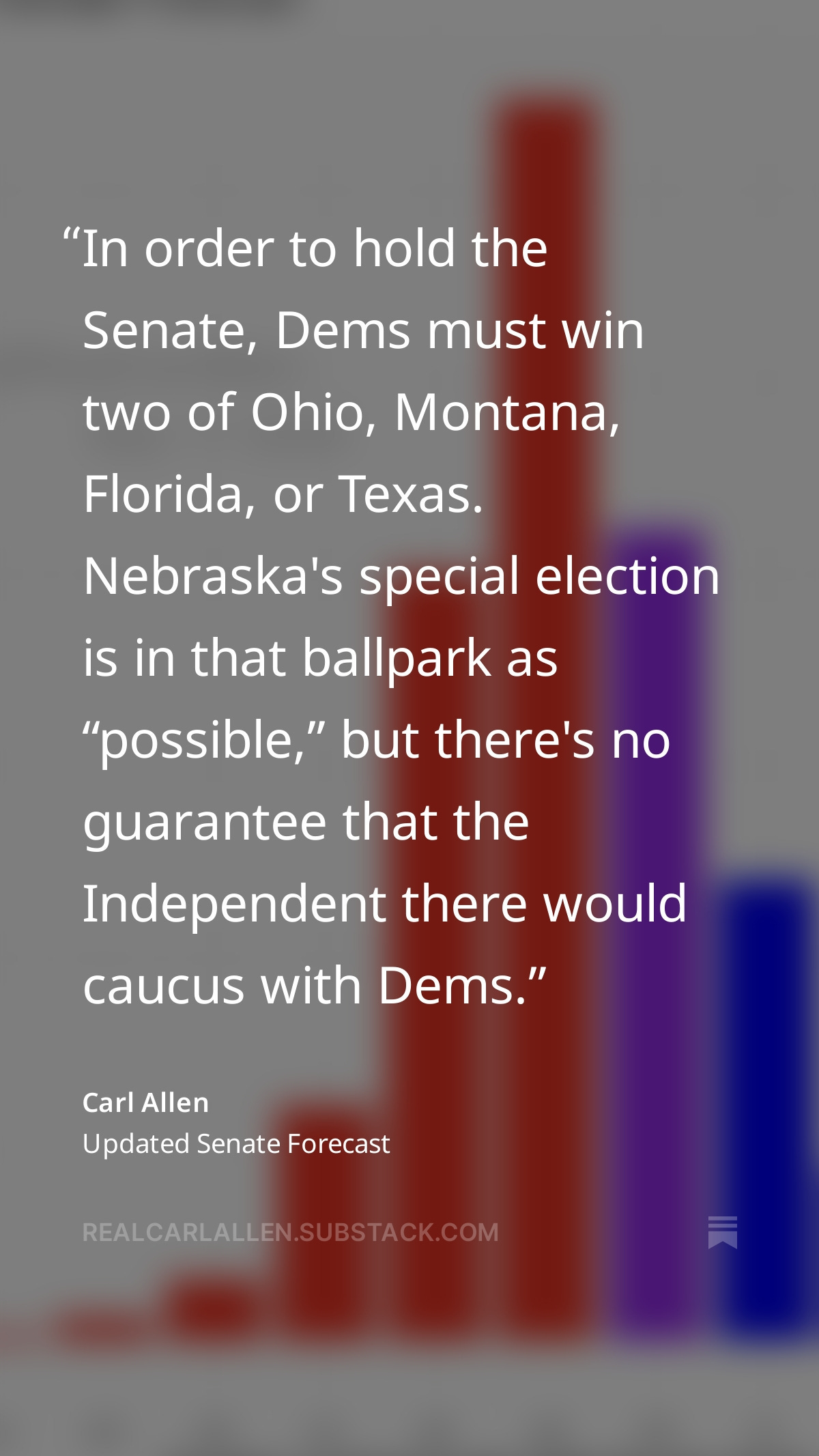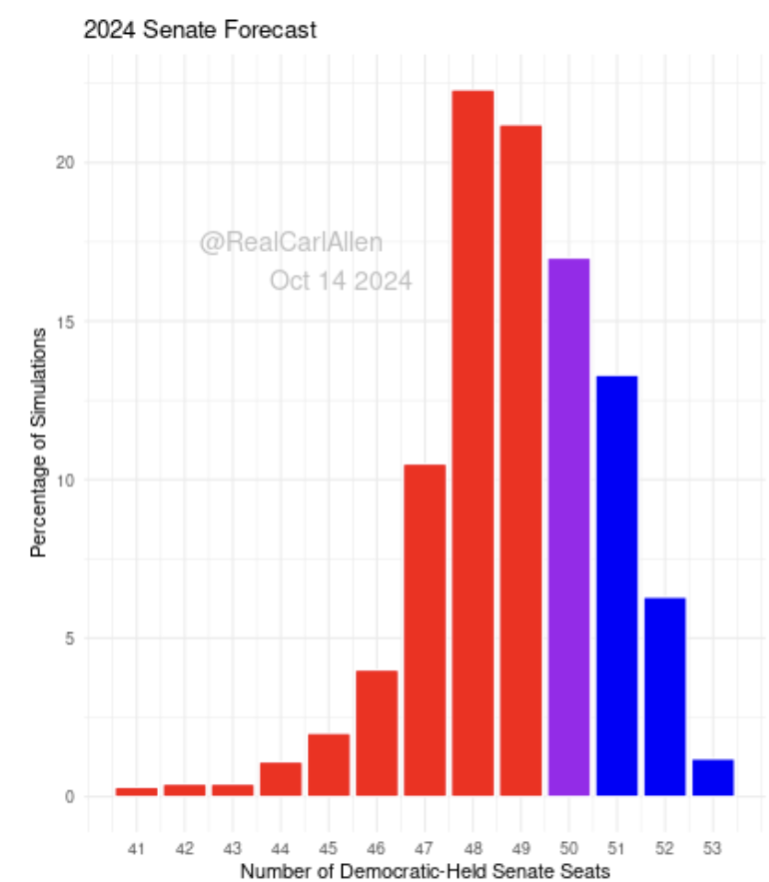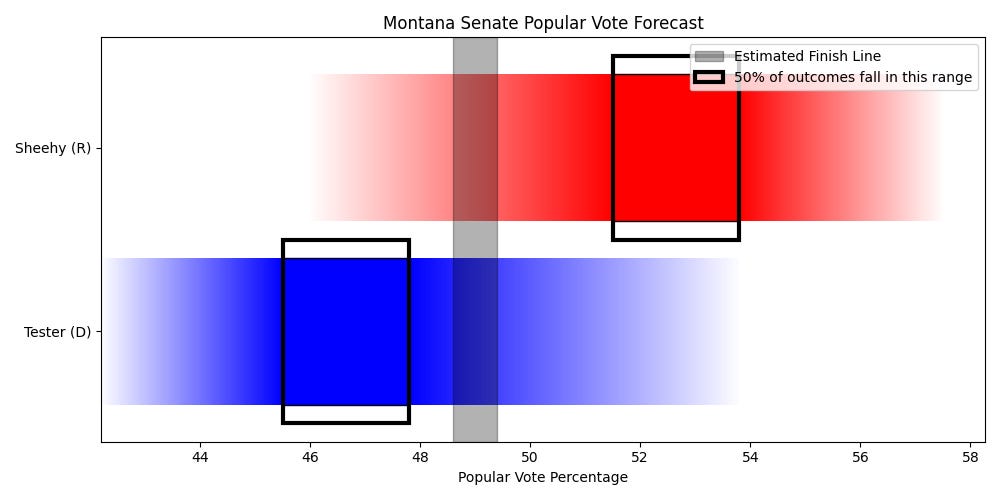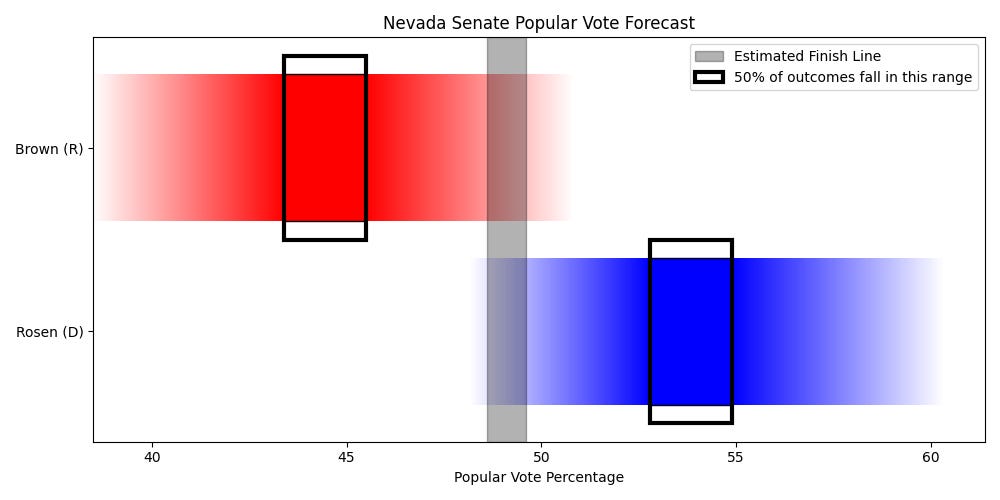The fact remains: Democrats have to play a very unfavorable hand in the 2024 Senate map.
Even in a good election for Dems, there's a chance they don't hold the Senate. In a bad election, they could lose 5 or more seats.
Here is my initial Senate forecast
And here is my previous update
From my last update:
Of these seats, Ohio is the best bet for Dems to hold.
I have them as slight to moderate favorites to do so (64%)
But that calculation comes with wide error bars: Trump is likely to run well ahead of Harris in Ohio, and his presence on the ballot will bolster the Republican Senate candidate.
Almost everyone understands (now, though most didn’t as recently as 2016) that states are correlated in the Electoral College.
But I think I'm the only one whose forecast incorporates the (I believe) indisputable fact that intrastate (e.g. President and Senate) races are also correlated.
One of the hardest job a forecaster has is finding a “lean” for undecideds - but sometimes there's good data for that in upballot or downballot races.
Ticket splitting is more prevalent in some states, and may be higher than usual in some places (candidates like Brown and Tester have done a good job separating themselves from the national conversation)
But we can't just assume no impact when the same people are voting on the same ballots. This is as clear of a case for covariance as there can be.
See my full Presidential Forecast (as of today) here.
Below is Ohio’s Presidential forecast.
The median outcome is roughly 53.8-45.5 here.
Contrary to other, less statistically astute analysts, I understand the importance of 50%.
In all elections, the “finish line” (percentage of votes that guarantees victory) can be short of 50% due to the presence of third parties; the finish line still matters, but the calculation becomes less certain (you'll note in my forecasts that the finish line varies in location and thickness to account for this).
In Ohio's Senate race, third parties might pull a few tenths, but 50% is basically the target for the winner.
In a good election for Trump, he pulls 55% or more of the vote in Ohio, Brown is an underdog: he needs to split a good portion of those ballots.
Whereas if Trump only gets to, say, 53%, Brown has a more achievable task.
As I stated in my Presidential forecast update:
Polls and poll averages are neither predictions, projections nor forecasts. They are an estimated base of support.
The fact that Tim Ryan was ahead at this time in 2022 in the Ohio poll average did not mean he was a favorite. There are more variables to account for.
In 2024, the fact that Sherrod Brown is ahead in the poll average also (in itself) doesn't mean he's a favorite.
If Brown wins, he's likely to do so with not much more than 50% of the vote.
Whereas his challenger, Moreno, despite being less likely to win, is more likely to hit 55% (thanks to Trump's coattails).
All in all, the Senate is easier to forecast than the Presidential Election, but they're highly correlated.
In more than 99% of the scenarios where Democrats hold the Senate (50+ seats, including Nebraska's Independent) they have also won the Presidency.
In many cases, they lose Ohio and/or Montana, but still retain the Presidency.
In most scenarios where they hold 49 seats (almost always, but not always Ohio) they win the Presidency.
As you'll see, the “left tail” where they lose in Senate seats in states like Wisconsin, Michigan, even Arizona or Pennsylvania, though not “likely” correlates closely to a Trump blowout from my Presidential Forecast: if Republicans win that state in the Presidency, it's much more likely they've won the Senate seat. And if one goes, the domino effect is quick.
Here is the Senate range of outcomes
Democrats - if you include Nebraska's Independent - have about a 37% chance of holding the Senate.
Here is what that probability looks like in each state:
Ohio, far from certain, favors Democrats slightly. But that would only be the 49th seat.
The 50th seat is (at least to me) really interesting
Any of Montana, Nebraska, Florida, or Texas could be the 50th, and none of them would be extremely surprising.
On that note, in the spirit of “admitting when I'm wrong” (if I'm going to demand other people do it, I should also do it)
In response to this post in August speaking about Nebraska - I said that it was likely that Fischer wins by double digits, and we should not "dream" on this race.
Well, by mid September that appeared like less of a dream, and now it might be the most likely 50th seat (if he caucuses with Dems).
I still “only” have it around 1/3, with wide “error bars” (as you'll see on my popular vote forecast) but the fact is, it's much higher than the 2% chance I put it on in August. My cone of uncertainty is getting tested in that one.
Due to the regression of Montana and Texas, though, Nebraska becoming more favorable for Dems hasn't boosted overall win probability much compared to the last update, just given Democrats more “outs” to get to 50…and slightly more likely to hit 51+.
Popular vote forecast by seat
Here they are in (approximate) order: most competitive to least competitive.




















Hi Carl, thanks for the post! I’m trying to understand your forecast model so I had a question. I notice you rank Montana as more likely to go blue than Texas and Florida. From my understanding, Sheehy (R) is currently leading in the polls for the Montana race with around 50-51% support, whereas Cruz (R) and Scott (R) both lead their races in Texas and Florida respectively with around 47-48% support.
It was my understanding from your work that leading in the polls at 50%+ is one of the strongest indications of being likely to win. Am I misunderstanding that, or missing anything extra that makes Sheehy’s higher numbers in the polls not equate to a more secure race?
Thanks again!
Seems likely to me that if Arizonans reject Kari Lake, That would also reject Trump since they share much the same policy and campaign style, unless the issue is more about gender